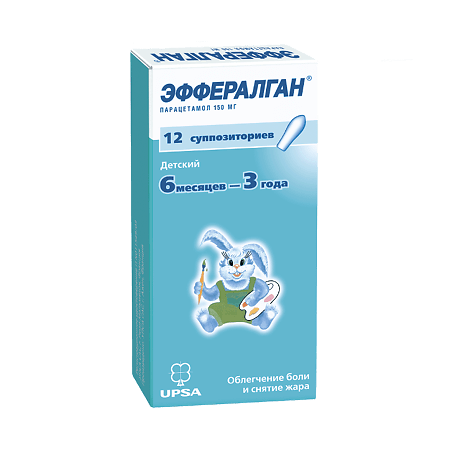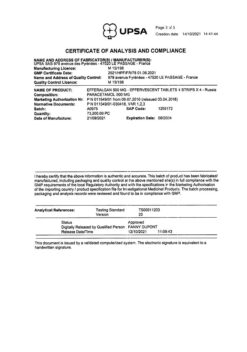No products in the cart.
Efferalgan, rectal 150 mg 12 pcs
€1.00
Out of stock
(E-mail when Stock is available)
Description
Efferalgan contains paracetamol, which blocks COX-1 and -2 mainly in the CNS, affecting the centers of pain and thermoregulation.
In inflamed tissues, cellular peroxidases neutralize the effect of paracetamol on COX, which explains the almost complete lack of anti-inflammatory effect.
The lack of blocking effect on GH synthesis in peripheral tissues explains its lack of negative effect on water-salt metabolism (Na+ and water retention) and gastrointestinal mucosa.
The suppositories have analgesic, antipyretic and mild anti-inflammatory effects.
Indications
Indications
Active ingredient
Active ingredient
Composition
Composition
1 suppository contains:
The active ingredient:
Paracetamol 150 mg;
Excipients:
Semisynthetic glycerides (solid fat) – 850 mg.
How to take, the dosage
How to take, the dosage
Rectally. After releasing the suppository from the package, introduce it into the child’s anus (preferably after a purging enema or spontaneous bowel emptying).
The average single dose of Efferalgane depends on the body weight of the child and is 10-15 mg/kg 3-4 times a day. The maximum daily dose should not exceed 60 mg/kg.
For children from Z to 5 months (with a body weight of 6-8 kg), 1 suppository (80 mg); 6 months to 3 years (with a body weight of 10-14 kg), 1 suppository (150 mg); 5-10 years (with a body weight of 20-30 kg), 1 suppository (300 mg) Z-4 times daily, 4-6 hours. Do not use more than 4 suppositories a day.
The treatment duration is 3 days as antipyretic and up to 5 days as analgesic.
When the drug is used for more than one week it is necessary to monitor the functional state of liver and peripheral blood picture.
Interaction
Interaction
Phenytoin reduces the effectiveness of paracetamol and increases the risk of hepatotoxicity. Patients taking phenytoin should avoid frequent use of paracetamol, especially in high doses. Patients should be monitored to rule out hepatotoxicity.
Probenecid reduces the clearance of paracetamol by almost 2-fold by inhibiting its conjugation with glucuronic acid. With concomitant use, consideration should be given to reducing the dose of paracetamol.
Cautiousness should be observed when concomitant use of paracetamol and inducers of microsomal liver enzymes (e.g., ethanol, barbiturates, isoniazid, rifampicin, carbamazepine, anticoagulants, zidovudine, amoxycillin + clavulanic acid, phenylbutazone, tricyclic antidepressants).
Long-term use of barbiturates reduces the effectiveness of paracetamol.
Salicylamide increases the T1/2 of paracetamol.
The international normalized ratio (INR) should be monitored during and after concomitant use of paracetamol, (especially in high doses and/or for prolonged periods) and coumarins (e.g., warfarin), because paracetamol when taken at a dose of 4 g for at least 4 days may increase the effect of indirect anticoagulants.
The attending physician must be informed about the use of Efferalgan® when taking uric acid and blood glucose tests.
Special Instructions
Special Instructions
Consult a doctor before taking the drug.
When using the drug for more than a week, monitoring of liver function and peripheral blood counts is necessary.
Paracetamol taken in doses greater than those recommended can cause serious liver damage.
There is a risk of overdose in patients with liver disease, chronic alcoholism, chronic malnutrition (due to low glutathione stores in hepatocytes), and in patients receiving microsomal liver enzyme inducers.
To avoid the risk of overdose, concomitant administration of Efferalgan ® and other drugs containing paracetamol is not recommended.
Paracetamol may cause serious skin reactions such as acute generalized exanthematous pustulosis, Stevens-Johnson syndrome, toxic epidermal necrolysis, which may be fatal. At the first manifestation of rash or other hypersensitivity reactions the use of the drug should be discontinued.
Contraindications
Contraindications
The drug should be used with caution in impaired liver function, Gilbert syndrome, dehydration, hypovolemia, and anorexia, bulimia or cachexia (insufficient glutathione reserve in the liver).
Consult a doctor before taking the drug.
In patients with impaired renal function, the time interval between doses of the drug should be at least 8 hours if creatinine clearance (CK) is less than 10 ml/min, at least 6 hours if CK is greater than or equal to 10 ml/min.
The drug should not be used if the child has diarrhea.
Side effects
Side effects
In rare cases nausea, vomiting, allergic reactions (skin rash, pruritus, urticaria, Quincke’s edema), rectal mucosa irritation, tenesmus are possible; anemia, thrombocytopenia, methemoglobinemia, leukopenia, neutropenia are extremely rare.
Hepatotoxic and nephrotoxic effects are possible with long-term use in high doses.
Overdose
Overdose
Symptoms:The signs of acute paracetamol poisoning are nausea, vomiting, anorexia, pain in the epigastric region, sweating, pale skin, appearing in the first 24 hours after intake. Administration of paracetamol at a dose of 140 mg/kg body weight in children causes destruction of liver cells, leading to complete and irreversible hepatonecrosis, liver failure, metabolic acidosis, encephalopathy, which in turn can lead to coma and death.
In 12-48 hours after intake, increased levels of liver transaminases (ALT, ACT), lactate dehydrogenase and bilirubin may be observed with a simultaneous decrease in prothrombin levels. The clinical picture of liver damage is usually detected after 1 or 2 days and reaches a maximum after 3-4 days.
Treatment: If symptoms of poisoning occur, discontinuation of the drug and immediate hospitalization is recommended. Blood samples should be taken for initial determination of plasma paracetamol levels. Gastric lavage is carried out in case of oral drug intake, enterosorbents (activated charcoal, lignin hydrolysis), administration of antidote acetylcysteine (IV or oral) within 8 hours after drug intake. Acetylcysteine may be effective even 16 hours after overdose. Symptomatic treatment is also carried out.
Hepatic tests should be performed at the beginning of treatment and then every 24 h. In most cases liver transaminase activity normalizes within 1-2 weeks. Liver transplantation may be necessary in very severe cases.
Hepatotoxic and nephrotoxic effects are possible with prolonged use in high doses.
Similarities
Similarities
Additional information
| Shelf life | 3 years |
|---|---|
| Conditions of storage | In a dry, light-protected place at a temperature not exceeding 30 ºC. |
| Manufacturer | UTSA SAS, France |
| Medication form | rectal suppositories |
| Brand | UTSA SAS |
Other forms…
Related products
Buy Efferalgan, rectal 150 mg 12 pcs with delivery to USA, UK, Europe and over 120 other countries.
















